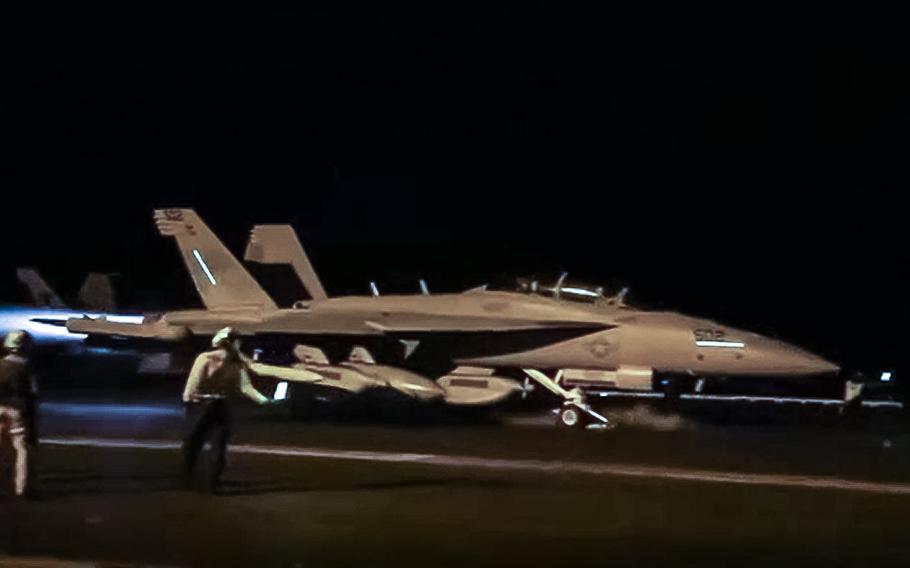
A video screen grab shows an F/A-18 Super Hornet taking off from the aircraft carrier USS Dwight D. Eisenhower on Jan. 11, 2024, to target Houthi militant sites in Yemen. (U.S. Central Command)
The aircraft carrier USS Dwight D. Eisenhower and several Navy destroyers played a sizable role Thursday in U.S.-led strikes on sites in Yemen that Houthi militants have used repeatedly to launch attacks on commercial ships in the Red Sea.
U.S. Central Command did not state which Navy ships were involved in strikes coordinated with the U.K. and supported by Australia, Bahrain, Canada and the Netherlands. But it did release video showing F/A-18 Super Hornet fighter jets and E-2 Hawkeye command-and-control aircraft launching from Eisenhower.

An F/A-18 Super Hornet launches from the flight deck of the USS Dwight D. Eisenhower Jan. 11, 2024, to target Iranian-backed Houthi militant sites in Yemen, in a screenshot from a video posted by U.S. Central Command. (U.S. Central Command)
CENTCOM also released one photo showing a Tomahawk missile launch from an unidentified destroyer. The missiles, which can strike targets more than 1,000 miles away, also were launched from at least one submarine in the Red Sea, The Associated Press reported Friday.
More than 100 precision-guided munitions were used against 60 targets at 16 Houthi militant sites, U.S. Air Force Lt. Gen. Alex Grynkewich said Thursday in a statement. Air Force planes also were used in the strikes.
Those targets included munitions depots, launching systems, productions facilities and air defense radar systems used by the Iranian-backed group in its attacks on ships in the Red Sea, said Grynkewich, commander of U.S. Air Forces Central.
The Houthis say their attacks are in solidarity with Hamas in its war with Israel, though in multiple cases the ships being fired upon had indirect or no clear ties with Israeli citizens.
At least five people were killed and six wounded by the U.S.-led strikes, according to Houthi sources cited in an AP report.
The strikes were lauded by some U.S. lawmakers and challenged by others who questioned President Joe Biden’s authority to order them without congressional approval. Former President Donald Trump drew similar reactions when he ordered a Tomahawk missile strike on Syrian government sites in 2017.
In the weeks leading up to Thursday’s action, some former U.S. military leaders expressed increasing concerns about the safety of U.S. service members and impacts to international trade should the Houthi attacks go unanswered.
The U.S. needs to take further action and send a strong message, retired Adm. James Foggo, who led U.S. Naval Forces Europe-Africa and Allied Joint Forces Command Naples from 2017 to 2020, said to Stars and Stripes last month.
That action “needs to be deliberate and it needs to be significant,” said Foggo, now dean of the Center for Maritime Strategy of the Navy League. “Those (Houthi) sources of weapons need to be destroyed.”
There are at least six Navy surface ships in the Red Sea, including Eisenhower and its escorts the cruiser USS Philippine Sea and destroyers USS Gravely and USS Mason. Two other destroyers, USS Carney and USS Laboon, also are in the region.
The guided-missile submarine USS Florida also is presumed to be in the Red Sea. The submarine and destroyers can carry 154 and 90 Tomahawk missiles, respectively.
That naval presence was initially part of a U.S. effort to keep the Israel-Hamas war from broadening across the region. But last month, the U.S. announced the formation of a multinational task force — Operation Prosperity Guardian —to address Houthi attacks on commercial ships in the Red Sea.
U.S. officials on Friday were quick to distance the task force, which includes the British navy ship HMS Diamond, from the strikes. Open-source intelligence analysts on the social media platform X, formerly known as Twitter, have identified two other British warships as well as those from Greece, Denmark and India as part of the task force.
Nearly 7,000 U.S. sailors and Marines are serving in the region, including about 5,000 service members aboard Eisenhower. Four F/A-18 Super Hornet strike fighter squadrons, an E-2 Hawkeye early warning squadron and an EA-18G Growler electronic attack squadron are aboard the carrier as part of Carrier Air Wing 3, according to a Navy statement on Oct. 14, when the Eisenhower deployed.
The air wing also includes MH-60S Knighthawk and MH-60R Seahawk helicopter squadrons, according to the statement.
U.S. destroyers, which have been active in repelling Houthi-launched attack drones and missiles, are equipped with the Aegis weapons platform, which has a sophisticated radar system that can search for, track and guide missiles simultaneously. It can track up to 100 targets, according to the Navy.